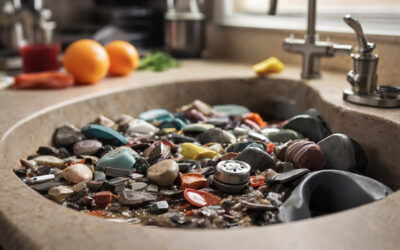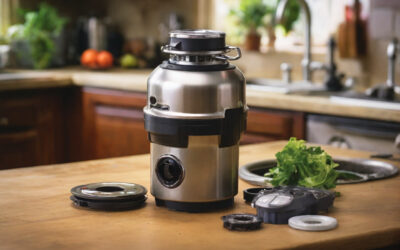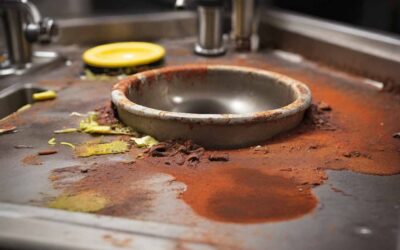Pouring boiling water down a drain to address frozen pipes may seem like a direct and efficient solution. However, this method, despite its apparent simplicity, entails significant risks and might not be the most advisable strategy for mitigating frozen plumbing issues. In this article, we delve into the consequences of using boiling water to thaw frozen pipes and suggest alternative, safer methods for managing this prevalent winter plumbing challenge. Asking “can you pour boiling water down the drain to unfreeze pipes?” reveals a common misconception about a seemingly quick fix that can cause more harm than good.
What Is A Frozen Pipe
When temperatures significantly drop, water inside pipes can freeze, leading to expansion and increased pressure on the pipes. This condition can restrict water flow or even cause pipes to burst, resulting in substantial damage and necessitating expensive repairs. The instinctual response might be to rapidly thaw the ice using the hottest water available; however, this approach can be more detrimental than beneficial.

What Causes Drain Pipes to Freeze?
Drain pipes freeze due to a combination of factors, primarily exposure to severely cold temperatures and lack of insulation. When the water inside the pipes has exposure to freezing temperatures. It starts to freeze, starting from the outer walls of the pipe and moving inward. This process can be exacerbated by several conditions:
Drops in Temperature
Sudden and extreme drops in temperature can cause the water in pipes to freeze more quickly than the heating system can compensate for.
Poor Circulation
Pipes with the most rare use or little water flow are more likely to freeze. It is casual if the moving water has a lower freezing point than stagnant water.
Thermal Bridging
When pipes are in contact with materials that conduct cold more efficiently, such as metal conduits or external walls without proper insulation, they can freeze more readily.

Wind Chill
Pipes exposed to the exterior or in poorly sealed spaces can freeze due to wind chill, where the cooling effect of wind lowers the temperature around the pipes more than the ambient temperature.
What Needs to Be Done for a Frozen Burst Pipe?
In the event of a frozen burst pipe, swiftly shut off the water main, drain the pipes, turn off nearby electricity, document the damage, contact a professional for repairs, and begin cleanup to minimize water damage and hasten recovery. When a pipe freezes and bursts, it requires immediate action to minimize water damage and facilitate repairs:
Shut Off the Water Main
Immediately turn off the main water supply to the house to stop water flow to the burst pipe. This is the most crucial step to prevent further water damage.
Drain the Pipes
Open all faucets to drain the remaining cold water and relieve any built-up pressure. This helps to prevent any more water from leaking through the burst pipe.
Turn Off Electricity
If the burst pipe is near electrical lines or outlets, turn off the electricity to that area to prevent electrical hazards.
Document the Damage
Take photos or videos of the damage for insurance purposes. Be thorough in documenting all affected areas and items.
Contact a Professional
A burst pipe often requires professional repair. Contact a licensed plumber to assess the damage and replace or repair the burst section of the pipe.
Begin Cleanup Immediately
To prevent mold and further water damage, start cleaning up the water as soon as possible. Use towels, mops, and a wet/dry vacuum if available. Consider hiring a professional water damage restoration service for extensive damage.
Insulate Pipes
Once you make repairs, take preventive measures to avoid future freezes by insulating pipes. Especially take care of the pipes that are exposed or in unheated areas.
Addressing a burst pipe efficiently can help mitigate the damage and restore your plumbing system’s integrity. It’s also important to take proactive steps to prevent pipes from freezing in the future, such as adding insulation and keeping your home at a consistent temperature.
Can you pour boiling water down the drain to unfreeze pipes?
No, we do not recommend pouring boiling water down the drain to unfreeze pipes. While this method might seem like a quick fix, it can cause more harm than good.
Here are the reasons why:
Thermal Shock
Sudden exposure to extreme temperatures can lead to thermal shock in pipes, particularly those made of metal. This rapid change can cause pipes to crack or burst due to the abrupt expansion and contraction, exacerbating the existing problem.
Material Damage
Different materials react differently to heat. PVC pipes, for example, may become soft or warp when exposed to boiling water, compromising their structural integrity. Metal pipes, while more resistant to heat, are not immune to the adverse effects of thermal shock.
Ineffectiveness of Thick Ice
Boiling water may initially seem effective, but its heat dissipates quickly upon contact with ice, reducing its efficacy. It might melt a thin layer of ice but is unlikely to thaw a pipe that is completely frozen through.
Potential for Injury
Pouring boiling water poses a risk of burns or injuries. The process of carrying and pouring the water, especially in a confined space or near slippery surfaces, can lead to accidents.
Alternative Solutions
If pouring boiling water down the drain is not feasible or safe, consider these alternative methods to unfreeze pipes:
Apply Heat
Use a hairdryer, heat lamp, or heating pad to apply gentle heat directly to the frozen area of the pipe. Be sure to keep flammable materials away from the heat source and avoid using open flames, such as blowtorches, which can pose a fire hazard.
Use a Pipe Thawing Device
Pipe thawing devices, available at hardware stores, are designed specifically to safely thaw frozen pipes. These devices use an electric current to generate heat and can be effective for stubborn blockages.
Seek Professional Help
If you’re unable to thaw the pipes yourself or if you suspect a pipe may be damaged, it’s best to seek the assistance of a licensed plumber. A professional can safely assess the situation, thaw the pipes, and make any necessary repairs to prevent future issues.
Step-by-Step Process to Thaw Frozen Pipes
Turn Off the Water Main
Before attempting to thaw the pipe, shut off the main water supply. This precaution reduces water flow and pressure to the area, decreasing the risk of a pipe bursting during the thawing process.
Open Faucet
Open the faucet that the pipe supplies. This allows water to flow through the pipe, helping to melt the ice and relieve built-up pressure.
Apply Heat
Begin to apply heat to the section of the pipe that is frozen using a hair dryer, heat lamp, electric heating pad, or towels soaked in hot water. Never use open flame devices such as a blowtorch, kerosene or propane heater, or charcoal stove, as these can cause damage or start a fire.
Thaw from Faucet Backwards
Start near the faucet and work your way down to the coldest section of the pipe. This approach helps ensure that melting ice and steam can escape through the open faucet.
Check for Leaks
After thawing the pipe and restoring water flow, check for any leaks or damage along the pipe. If you find any damage, turn off the water supply and contact a professional plumber for repairs.
Safer Alternatives to Thaw Frozen Pipes
Given the risks associated with pouring boiling water down a drain, consider these safer alternatives:
Gradual Warming
Use a hair dryer, heat lamp, or portable heater to gently warm the affected section of the pipe. Keep the device moving to distribute heat evenly and prevent overheating in any single area.
Electrical Heating Tape
Apply electrical heating tape directly to the pipe. This tape distributes heat along the pipe’s length, helping to thaw the ice without causing damage.
Increase Ambient Temperature
If the frozen pipe is in a location like a basement or a garage, raising the overall temperature of the room can help thaw the pipe gradually.
Professional Assistance
For severe cases, or if you are unsure about safely thawing the pipes yourself, it is advisable to seek professional plumbing services. Plumbers have the tools and expertise to address frozen pipes without causing further damage.
Maintaining the Perfect House Temperature
To prevent pipes from freezing and to maintain an energy-efficient home, it’s crucial to keep your house at an optimal temperature during the winter months. The ideal house temperature for both comfort and efficiency, according to the U.S. Department of Energy, is:
- 68°F (20°C) during the day: This temperature is comfortable for most people and can help conserve energy when you’re home and awake.
- Lower at night or when you’re away: Reducing the thermostat by 7-10 degrees Fahrenheit (about 4-6 degrees Celsius) from your daytime setting during sleeping hours or when the house is unoccupied can save energy and reduce your heating bill without risking frozen pipes.
Preventive Measures for Freezing Pipes
To prevent the inconvenience and costly repairs associated with frozen and burst pipes during the winter, proactive measures are essential. By insulating pipes, maintaining a consistent indoor temperature, and addressing vulnerabilities in your plumbing system, you can protect your home against freezing pipes.
These steps not only ensure a continuous water supply but also safeguard your home’s structural integrity and prevent potential water damage, keeping your living environment warm and secure against the cold.
Prevention is key to avoiding the hassle and expense of dealing with frozen pipes. Thus, the question “Can you pour boiling water down the drain to unfreeze pipes?” should be approached with caution, favoring more protective and effective measures.
Insulate Pipes
Use foam pipe insulation to cover exposed pipes in unheated areas like basements, attics, and garages. For extra protection, consider using thermostatically controlled heat tape.
Seal Leaks
Identify and seal leaks where cold air may enter, especially around utility service areas, windows, and doors. Even small openings can lead to significant heat loss and expose pipes to freezing temperatures.
Let Faucets Drip
Allowing a trickle of water to flow through the pipes can prevent freezing. The movement of water relieves built-up pressure in the pipes, reducing the chance of a burst.
Drain Systems
Before winter, drain water from swimming pool lines, sprinkler systems, and outdoor hoses. Close inside valves supplying outdoor hose bibs and open the outside hose bibs to allow water to drain.
Conclusion
While pouring boiling water down a drain might appear to be a quick fix for frozen pipes, the potential for damage and injury makes it an inadvisable solution. Adopting a more measured approach, such as gradually warming the pipes or employing professional help, is a safer and more effective strategy for resolving frozen plumbing issues. This highlights the importance of seeking safer alternatives rather than relying on the risky method of “can you pour boiling water down the drain to unfreeze pipes?”
FAQ
- What is the first thing I should do if I discover a frozen pipe?
A: Immediately shut off the main water supply to prevent water pressure from building up and causing the pipe to burst. Then, gently apply heat to the frozen section using a hair dryer, electric heating pad, or warm towels. Avoid using open flames as they pose a fire risk.
- How can I tell if a pipe is frozen before it bursts?
A: Look for visible signs such as frost on the pipe or bulging areas, which indicate freezing. Reduced water flow or no water coming out of the faucet can also signal a frozen pipe. In some cases, strange noises from the pipes, like clanking or bubbling sounds, might be heard.
- Are certain pipes more prone to freezing than others?
A: Yes, pipes in unheated interior spaces like basements, attics, garages, and under kitchen and bathroom cabinets are more susceptible to freezing. Pipes running through exterior walls with insufficient insulation are also at high risk.
- Can insulation help prevent pipes from freezing?
A: Absolutely. Insulating exposed pipes with foam pipe insulation helps maintain higher temperatures in the pipes, significantly reducing the risk of freezing. For extra protection in very cold climates, consider adding electric heat tape before insulating.
- What temperature should I keep in my house to prevent the pipes from freezing?
A: Keep your house temperature at least 68°F (20°C) during the day. At night or when you are away, it can get lower slightly. So, ensure it never falls below 55°F (13°C) to prevent the interior pipes from freezing, especially in extremely cold weather.





